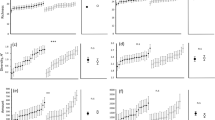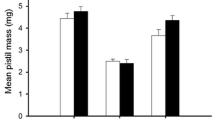Abstract
In this article, we analyzed the concentration of coumarins in leaves of female and hermaphrodite individuals of the gynodioecious shrub Daphne laureola, along an elevational gradient in southern Spain. Combining HPLC and NMR techniques, we identified three different glycosides of 7-methoxy-coumarin in leaves of this species. Total coumarin concentration averaged between 60 and 120 mg/g dry weight for mature summer leaves of D. laureola growing at six different populations. As predicted by optimal theory, females tended to have a higher concentration of coumarins than hermaphrodites, thus upholding the idea that male reproductive function is costly for hermaphrodites. Furthermore, concentrations in females but not hermaphrodites were positively correlated with increasing population altitude, and the magnitude of gender divergence in coumarin concentration varied among populations, suggesting that the cost of the male function may be context dependent. To our knowledge, this is the first evidence of gender differences in chemical defenses of a gynodioecious species in the field.
Similar content being viewed by others
References
Ågren, J., Danell, K., Elmqvist, T., Ericson, L., and Hjältén, J. 1999. Sexual dimorphism and biotic interactions, pp. 217–246, M. A. Geber, T. E. Dawson, and L. F. Delph (eds.). Gender and Sexual Dimorphism in Flowering Plants. Springer, Berlin.
Alonso, C. and Herrera, C. M. 1996. Variation in herbivory within and among plants of Daphne laureola (Thymelaeaceae): Correlation with plant size and architecture. J. Ecol. 84:495–502.
Alonso, C. and Herrera, C. M. 2000. Seasonal variation in leaf characteristics and food selection by larval noctuids on an evergreen Mediterranean shrub. Acta Oecol. 21:257–265.
Alonso, C. and Herrera, C. M. 2001. Neither vegetative nor reproductive advantages account for high frequency of male-steriles in southern Spanish gynodioecious Daphne laureola (Thymelaeaceae). Am. J. Bot. 88:1016–1024.
Alonso, C. and Herrera, C. M. 2003. Developmental and spatial covariation of nutrients in growing leaves of Daphne laureola and their relationships with herbivory. New Phytol. 159:645–656.
Ashman, T.-L. 2002. The role of herbivores in the evolution of separate sexes from hermaphroditism. Ecology 83:1175–1184.
Berenbaum, M. R. 2001. Chemical mediation of coevolution: phylogenetic evidence for Apiaceae and associates. Ann. Mo. Bot. Gard. 88:45–59.
Boecklen, W. J., Price, P. W., and Mopper, S. 1990. Sex and drugs and herbivores: sex-biased herbivory in arroyo willow (Salix lasiolepis). Ecology 71:581–588.
Brown, S. A. 1970. Biosynthesis of furanocoumarins in parsnips. Phytochemistry 9:2471–2475.
Cipollini, D., Purrington, C. B., and Bergelson, J. 2003. Costs of induced responses in plants. Basic Appl. Ecol. 4:79–85.
Collin, C. L., Pennings, P. S., Rueffler, C., W idmer, S., and Shykoff, J. A. 2002. Natural enemies and sex: How seed predators and pathogens contribute to sex-differential reproductive success in a gynodioecious plant. Oecologia 131:94–102.
Delph, L. F. 1990. Sex-differential resource allocation patterns in the subdioecious shrub Hebe subalpina. Ecology 71:1342–1351.
Dudt, J. F. and Shure, D. J. 1994. The influence of light and nutrients on foliar phenolics and insect herbivory. Ecology 75:86–98.
Eckhart, V. M. and Seger, J. 1999. Phenological and developmental costs of male sex function in hermaphroditic plants, pp. 195–213, T. O. Vuorisalo and P. K. Mutikainen (eds.). Life History Evolution in Plants. Kluwer, Dordrecht.
Fung, S.-Y. and Herrebout, W. M. 1987. Coumarins in Prunus mahaleb and its herbivore the small ermine moth Yponomeuta mahalebellus. J. Chem. Ecol. 13:2041–2047.
Gömez, D., Azorín, J., Bastida, J., Viladomat, F., and Codina, C. 2003. Seasonal and spatial variations of alkaloids in Merendera montanain relation to chemical defense and phenology. J. Chem. Ecol. 29:1117–1126.
Gouyon, P. H. and Vernet, P. 1980. Étude la de variabilitégénétique dans une population de Thymus vulgaris L. Observations sur le polymorphismes sexuel et chimique, effets du régime de reproduction. Acta Oecol., Oecol. Plant. 1:165–178.
Hegnauer, R. 1973. Chemotaxonomie der Pflanzen. VI. Thymeleaeceae. Birkauser Verlag, Basel.
Herms, D. A. and Mattson, W. J. 1992. The dilemma of plants to grow or to defend. Quart. Rev. Biol. 67:283–334.
Hoy, C. W., Head, G. P., and Hall, F. R. 1998. Spatial heterogeneity and insect adaptation to toxins. Annu. Rev. Entomol. 43:571–594.
Jing, S. W. and Coley, P. D. 1990. Dioecy and herbivory: The effect of growth rate on plant defense in Acer negundo. Oikos 58:369–377.
Johnson, K. and Scriber, J. M. 1994. Geographic variation in plant allelochemicals of significance to insect herbivores, pp. 7–31, T. N. Ananthakrishnan (ed.). Functional Dynamics of Phytophagous Insects. Science Publishers, Lebanon, New Hampshire, USA.
Jung, M., Zinsmeister, H. D., and Geiger, H. 1994. New three- and tetraoxygenated coumarin glucosides from the mosses Atrichum undulatumand Polytrichum formosum. Z. Naturforsch 49c:697–702.
Konishi, T., Wada, S., and Kiyosawa, S. 1993. Constituents of the leaves of Daphne pseudo-mezereum. Yakugaku Zasshi J. Pharm. Soc. Jap. 113:670–675.
Louda, S. M. and Rodman, J. E. 1983. Ecological patterns in the glucosinolate content of a native mustard, Cardamine cordifolia, in the Rocky Mountains. J. Chem. Ecol. 9:397–422.
Marshall, M. and Ganders, F. R. 2001. Sex-biased seed predation and the maintenance of females in a gynodioecious plant. Am. J. Bot. 88:1437–1443.
Maynard-Smith, J. 1978. Optimization theory in evolution. Annu. Rev. Entomol. 9:31–56.
Murray, R. D. H., Méndez, J., and Brown, S. A. 1982. The Natural Coumarins. Occurrence, Chemistry and Biochemistry. Wiley, Chichester, UK.
Obeso, J. R. 2002. Tansley review no. 139. The costs of reproduction in plants. New Phytol. 155:321–348.
Rozema, J., Chardonnens, A., Tosserams, M., H afkenscheid, R. and Bruijnzeel, S. 1997. Leaf thickness and UV-B absorbing pigments of plants in relation to an elevational gradient along the Blue Mountains, Jamaica. Plant Ecology 128:151–159.
Salmore, A. K. and Hunter, M. D. 2001. Elevational trends in defense chemistry, vegetation, and reproduction in Sanguinaria canadensis. J. Chem. Ecol. 27:1713–1727.
SAS Institute. 1996. SAS/STAT Software: Changes and Enhancements Through Release 6.11. SAS Institute, Cary, North Carolina.
Stratmann, J. 2003. Ultraviolet-B radiation co-opts defense signalling pathways. Trends. Plant. Sci. 8:526–533.
Thompson, H. J. and Brown, S. A. 1984. Separations of some coumarins of higher plants by liquid chromatography. J. Chrom. 314:323–336.
Ulubelen, A., Terem, B., and Tuzlaci, E. 1986. Coumarins and flavonoids from Daphne gnidioides. J. Nat. Prod. 49:692–694.
Uno, G. E. 1982. Comparative reproductive biology of hermaphroditic and male-sterile Iris douglasiana Herb. (Iridaceae). Am. J. Bot. 69:818–823.
Zobel, A. M. and Brown, S. A. 1988. Localization of daphnetin and umbelliferone in different tissues of Daphne mezereum shoots. Can. J. Bot. 67:1456–1459.
Author information
Authors and Affiliations
Corresponding author
Rights and permissions
About this article
Cite this article
ALONSO, C., PÉREZ, R., NIETO, P.M. et al. GENDER DIMORPHISM AND ALTITUDINAL VARIATION OF SECONDARY COMPOUNDS IN LEAVES OF THE GYNODIOECIOUS SHRUB Daphne laureola. J Chem Ecol 31, 139–150 (2005). https://doi.org/10.1007/s10886-005-0980-6
Issue Date:
DOI: https://doi.org/10.1007/s10886-005-0980-6




